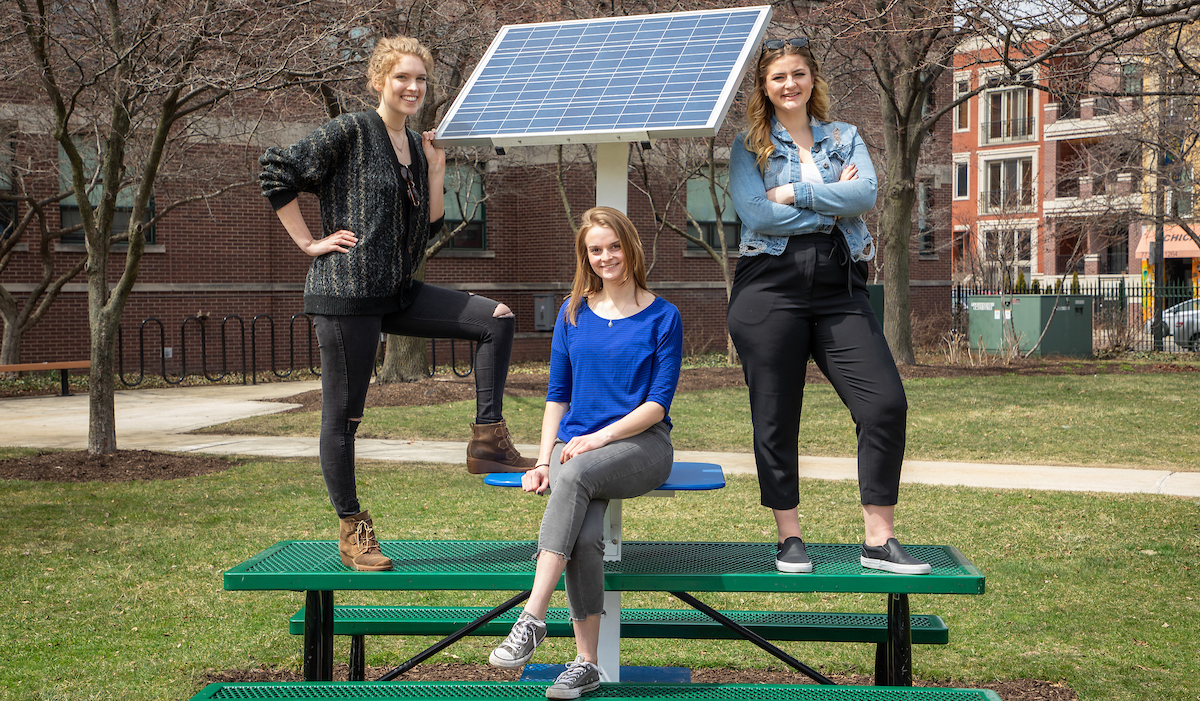 Left to right, Students Sydney Coyle, Katy Bozich and Anna Pierce are members of DePaul's Student Government Association, who helped lead the effort to have solar panels installed on the roofs of McGowan North and the 1150 West Fullerton buildings on the Lincoln Park Campus. (DePaul University/Jeff Carrion)
Left to right, Students Sydney Coyle, Katy Bozich and Anna Pierce are members of DePaul's Student Government Association, who helped lead the effort to have solar panels installed on the roofs of McGowan North and the 1150 West Fullerton buildings on the Lincoln Park Campus. (DePaul University/Jeff Carrion)
As the result of a joint effort between the Student Government Association and Facility Operations, DePaul is implementing the use of roof-top solar panels around its Lincoln Park campus. The first round of installations, which will be located atop the McGowan North and 1150 W. Fullerton buildings, is slated for this summer.
"We chose those two buildings for our initial foray into the field of photovoltaic solar systems as the roofing systems on these buildings are the newest on campus, which is an important factor given the projected life of the PV equipment," says Bob Janis, vice president of facility operations at DePaul. "That, and these systems have become more cost effective than they were even a few short years ago, so the time is right. If all goes well, these will be the first of a number of installations, a venture for which we have to thank the SGA."
The first round of PV systems, which convert sunlight - photons - directly into electricity - voltage - consist of 289 panels. They will generate nearly 100,000 watts of energy, offsetting a percentage of the buildings' electrical supply that is currently purchased through third-party energy providers. The panels are estimated to reduce carbon dioxide emissions by 83 tons each year - the equivalent of planting more than 3,000 trees.
"The goal of the project is to reduce DePaul's carbon footprint," says Sydney Coyle, SGA's senator for sustainability. "As a large institution, we have a responsibly to keep our environmental impact in check."
DePaul is one of the first universities in the Chicago area to use PV systems.
"We are at the forefront of a trend in which universities are deciding to use less dirty energy and focus more on renewables," Coyle says. "I hope these sustainability projects continue in the future and inspire other institutions in Chicago to adopt clean forms of energy."
In addition to their environmental benefits, the solar panels are projected to save the university $12,000 in energy costs annually.
"These PV panels will not only reduce reliance on dirty energy, but they'll save the university money that can hopefully be reallocated to other important programs," Coyle says.
The entire cost of the project will be covered by SGA's 2018-19 sustainability fund. In the past, this fund has provided water-bottle refill stations, motion-activated lighting systems and solar-powered recharging stations. To learn more about SGA's sustainability efforts,
visit its website.